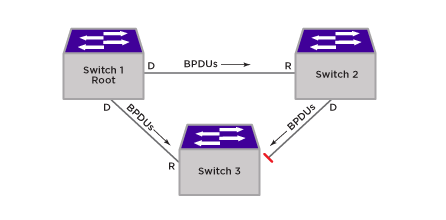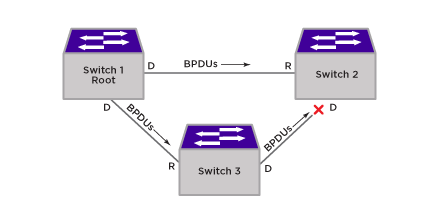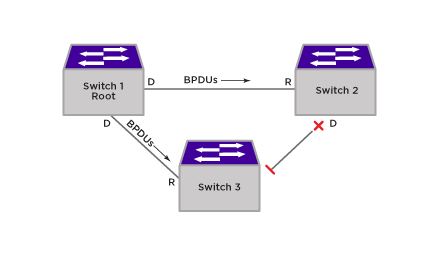Loop Protect Port Modes
Ports work in two Loop Protect operational modes.
- If the port has the partner loop protect as capable then it works in
full functional mode.
- If the port has the partner loop protect as incapable then it works
limited functional mode.
In full mode, when RSTP/MSTP (Multiple Spanning Tree Protocol) BPDUs is received
in point-to-point link and the port is designated, a Loop Protect timer is set to 3 times hello
time, when this timer expires then port will be moved to blocking state. Limited mode adds a
further requirement that the flags field in the BPDU indicates a root role.
Message age expiration and the expiration of the Loop Protect timer are both
events for which Loop Protect generates traps and a debug message. In addition, user can
configure Loop Protect to forcefully disable port when one or more events occur. When the
configured number of events happens within a given window of time, the port will be forced into
disable and held there until you manually unlock it.
The following example shows the loop due to the misconfiguration in
STP (Spanning Tree Protocol):
Switch 1 Elected as Root shows that
Switch 1 is elected as Root. Switch 2 and Switch 3 elect the root port. Switch3‘s port connected
to Switch2 is elected as Alternate port and it is port state is in blocking state.
STP Disabled on Switch 2 shows that
if the user accidentally disables the STP on Switch 2 port connected to Switch 3, Switch 2 will
stop sending the BDPU to Switch 3 since STP is disabled. Switch 3 assumes that neighbor is down
and it changes the port to forwarding state which will eventually create a loop.
Loop Protect Enabled shows that,
with loop protect enabled switch 3 will not go to forwarding state until it receives a BPDU from
switch 2 and the port state will be in discarding state.
When the Loop protect feature is enabled:
- On a Point-to-point Link, BPDU must be received before going to
Forwarding state.
- If a BPDU timeout occurs on a port, its state becomes DISCARDING until a
BPDU is received.
- When a root or alternate port loses its path to the root bridge due to a
message age expiration it takes on the role of designated port. It will not forward traffic
until a BPDU is received.
- When a port is intended to be the designated port in a point-to-point
link it constantly proposes and will not forward until a BPDU is received, and will revert to
discarding if it fails to get a response.
- If the partner is not Loop Protect Capable (Alternate Agreement not
supported), designated port will not be allowed to forward unless receiving agreements from a
port with root role.
- Legacy Spanning Tree (802.1d) or shared media devices should be
connected in a non-redundant fashion to avoid the possibility of looping.
You can enable the port by giving the command enable
port
port-list.




 Print
this page
Print
this page Email this topic
Email this topic Feedback
Feedback